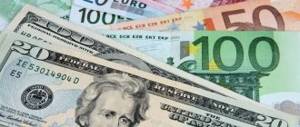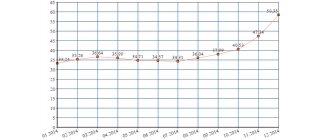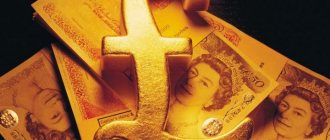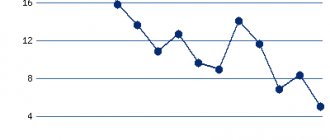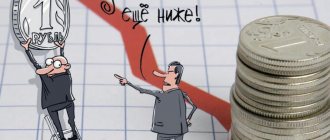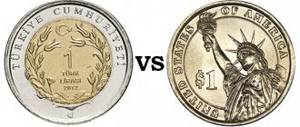Greetings! A couple of years ago, financial experts argued until they were hoarse on the topic: “Which type of exchange rate is more profitable for the domestic economy: free or fixed?”
Just imagine! Today, a dollar can be bought for 63 (or better, as before, for 30 rubles). And in a month - for 63, and in a year - also for 63 rubles. Beauty?
Such “stability” in the foreign exchange market of a single country can be achieved without serious reforms in the economy. It is enough just to use a fixed exchange rate at the level of the Central Bank.
Why was the ruble/dollar exchange rate allowed to float freely in Russia? And which rate is better for us: fixed or floating?
How it works?
The main motivation for fixing the exchange rate is to stimulate trade between countries by reducing currency risk. Many businesses make relatively small profits and changes in exchange rates can lead to a complete loss of profits, forcing firms to find new suppliers. This is especially true in retail, where competition is usually high. Countries tend to fix rates based on stronger or more developed economies so that domestic companies can enter wider markets with less risk. The US dollar, euro and gold have historically been popular choices. A fixed exchange rate creates stability between trading partners and such a peg can work for decades. For example, the Hong Kong dollar has been pegged to the US dollar since 1983.
Only fixing the exchange rate in accordance with reality, aimed at reducing volatility, can bring economic benefits. Setting the exchange rate artificially high or low creates an imbalance that ultimately harms all countries involved.
Rate
Floating course in Russia
For the first time, a regulated currency regime was initiated in Russia starting in 1999. The decision was made in connection with the default that took place in 1998. After unfavorable events in society, the Russian government was able to eliminate the negative influence of the external economy on the national financial sector. Already in 2005, the concept of a bi-currency basket was introduced, in which the tandem of the dollar and the euro was used. It opened up broad prospects for regulating the country's currency. After the ruble was pegged to the two most powerful currencies in the world, the focus on the exclusively US economy instantly weakened.
Until 2009, government authorities actively intervened in foreign exchange market quotes only in a situation where the value of a monetary unit began to actively move towards the border of the corridor. After the global crisis in 2008, the rule was abolished. The government can actively intervene in the movement of quotes, regardless of whether they are within the corridor or outside its boundaries.
Advantages of a fixed exchange rate
Fixed currencies can expand trade and boost real incomes, especially when currency movements are relatively low and show no long-term changes. When there is no exchange rate and tariff risk, individuals, companies and countries can benefit more from their specialization and currency exchange. According to the theory of comparative advantage, everyone will be able to spend more time doing what they do best.
Rate
With fixed exchange rates, farmers can simply produce the best food they can, rather than spending time and money hedging currency risk with derivatives. Likewise, technology companies will be able to focus on building better computers. And, perhaps most importantly, retailers in both countries will be able to source products from the most efficient producers. Fixed exchange rates make longer-term investments in another country possible. With a currency peg, fluctuating exchange rates are much less likely to disrupt supply chains and change the value of investments.
Floating exchange rate in countries around the world
The floating exchange rate regime is established in only 34% of countries in the world. The indicator includes 65 countries, of which 29 practice a floating exchange rate with interventions in rare cases, and 36 states practice setting the national currency exchange rate based solely on the market formation of demand and supply. The absolute floating exchange rate of the national currency is a phenomenon that has been fully implemented in 17 countries of the European Union. The remaining 13 countries have a 70% share of industry in exports. Only Mexico and Norway are included in the list of states that practice free floating of the national currency and specialize in oil production. The course is also actively practiced by Russia’s strategic partners. These are Türkiye, Brazil and India. These states have very soft currency interventions by the Central Bank. The floating exchange rate of the ruble, the consequences of which have already begun to actively manifest themselves, is not effective, since Russia is not characterized by the presence of a developed market for insurance of currency risks. Oil exporting countries with one specialization have different exchange rates, mostly stable and fixed.
Disadvantages of a fixed exchange rate
The central bank of a country with a fixed exchange rate must control supply and demand and manage cash flows to avoid surges in demand or supply. Large movements can cause the currency to deviate from its fixed value. This means that the central bank must have large foreign exchange reserves to counter excessive purchases or sales of its currency. Fixed exchange rates affect Forex trading by artificially curbing volatility.
Exchange Rates
Countries will face their own set of problems if the currency is pegged to an exchange rate that is too low. On the one hand, domestic consumers will be deprived of the purchasing power to buy foreign goods. Let's assume that the Chinese yuan is pegged too low to the US dollar. Chinese consumers would then have to pay more for imported food and services, lowering their consumption and living standards. On the other hand, American farmers and oil producers in the Middle East who would sell them more goods are losing business. This situation creates trade tensions between the country with the undervalued currency and the rest of the world.
Another set of problems arises when a currency is pegged at an excessively high rate. Because the government has set the rate too high, local consumers will buy too many imports and consume more than they can produce. Chronic trade deficits will create downward pressure on the domestic currency and the government will have to spend foreign exchange reserves to defend the peg. Government reserves will eventually be depleted and the peg will collapse.
When the fixed rate collapses, the country that set the rate too high will suddenly find imports more expensive. This means that inflation will rise and the nation may also have difficulty paying off debts. Another country will find its exporters losing markets and its investors losing money on foreign assets that are no longer worth as much in domestic currency terms. The biggest failures of the fixed rate are: the Argentine peso against the US dollar in 2002, the British pound against the German mark in 1992, and perhaps the US dollar against gold in 1971.
Why did we refuse to support the ruble on the interbank market?
In November 2014, the Central Bank of Russia abandoned regular interventions in the foreign exchange market. The currency corridor system that was used previously was abolished. Since the end of last year, the Bank of Russia has reserved the right to intervene only in the event of a real threat to the country’s financial stability.
In fact, the Central Bank planned to release the ruble into “free floating” by January 2015. But the currency corridor had to be abandoned two months earlier. Due to the abnormal activity of speculators, as well as serious problems in the economy and geopolitics.
Experts unanimously say: the transition to a floating exchange rate was inevitable. First of all, due to the external shocks of 2014-2015. Against the backdrop of Western sanctions and cheap oil, the ruble exchange rate has become a shock absorber for the Russian economy.
The main purpose of introducing a floating exchange rate is to preserve the country's gold and foreign exchange reserves. In 2014, Russia's gold and foreign currency reserves decreased by $100 billion. In the fourth quarter alone, $40 billion was spent to support the ruble. And spending reserves to maintain the “old” exchange rate further was simply dangerous.
Another advantage of devaluation (from the point of view of economists, not you and me) is the support of domestic exporters. In the conditions of 2015, the weak ruble helped fill the budget and accelerated import substitution. But only those exporters who had:
- There is no large share of foreign currency liabilities
- There are stable prices for products
Examples of such “lucky” ones: Norilsk Nickel, Acron and Uralkali. The majority of Russian exporters did not benefit from the devaluation, but lost.
Financial experts, officials and large exporters were able to appreciate the advantages of the free exchange rate of the ruble. But all residents of Russia felt the disadvantages. Prices for almost all goods increased by 50-100%, and real incomes of the population, on the contrary, fell.
Another inevitable disadvantage of a floating exchange rate is inflated rates on bank loans (from a banal credit card to a mortgage). I’m sure each of us has a couple of acquaintances who have personally encountered this side (and extremely unpleasant) effect of a free ruble.
Oh, there were times...
Analysts immediately rushed to calm the “alarmists.” They say that a weak national currency is like a high fever with the flu. At first you feel chills and fever, and then the body begins to resist the disease and adapts to new conditions. From the point of view of macroeconomists, this is a normal and “healthy” situation.
By the way, almost simultaneously with Russia, our neighbor Kazakhstan also switched to a flexible exchange rate. The main reason is the sharp devaluation of the Chinese yuan in August 2015.
Wrong Ideas
What the floating exchange rate of the ruble means and how useful it is for Russia is taught in higher educational institutions, despite the fact that all the information provided is erroneous. One of the economics textbooks provides the following data: “A floating exchange rate in the context of a country’s balance of payments deficit will be compared with a deficit, which will undoubtedly lead to a reduction in the influx of dollars into the territory of the state. The value of the national currency will systematically fall, as a result - a decrease in the cost of domestic goods, their popularization in the domestic market and an increase in exports. Further, the growth of exports will increase the influx of dollars, and the demand for foreign currency will fall, the ruble exchange rate will rise.” To some extent, this is correct, but when considering this issue, it is necessary to take into account that the rule is relevant for states that supply goods, the cost of which is formed exclusively from the costs of the domestic market. It will be easier to explain the threat of a floating ruble exchange rate if we consider that 72% of the state’s exports consist of oil and gas, and the cost of energy resources is formed exclusively on the international market. As a result, “free floating of the ruble” can neither lead to an increase in the exchange rate of the national currency nor to an increase in export volumes. In order to direct the benefits of this monetary policy in its direction, Russia had to diversify exports by product range, and not by partner countries, which is now being actively done under the pretext of diversification.
How are exchange rates and inflation related?
The exchange rate affects inflation, but the impact can be different, even the opposite. A weakening exchange rate may accelerate inflation in the short term, and contribute to its reduction in the medium term. When the domestic currency weakens, imported goods become more expensive. Purchasing equipment or raw materials abroad is becoming expensive. Therefore, the final product becomes more expensive. Thus, a weakening exchange rate accelerates inflation. But there is another side to the coin. For example, after the 2014 crisis, many Russian goods became cheaper than imported ones, and demand for them increased. Then the weakening of the ruble helped some producers (especially agricultural ones) expand production, organize production, maintain and even reduce prices. Accordingly, in this case, the weakening of the exchange rate curbs inflation.
This is a simplified diagram, in reality everything is more complicated - inflation is formed under the influence of a whole complex of factors.
Digital library
Finance and credit / International monetary relations / 7. Currency regime. Flexibility of exchange rates
Currency regime –
it is a way of setting the exchange rate.
Exchange rate flexibility
means its ability to respond to the relationship between supply and demand for a currency. Essentially, the flexibility of the exchange rate reflects the mode of its establishment by the monetary authorities.
In 1982, the International Monetary Fund compiled a classification of exchange rates according to the degree of flexibility:
1) fixed exchange rate;
2) limitedly flexible course;
3) floating exchange rate.
There are 6 types of fixed exchange rates:
1) rate fixed to one currency, the most significant in the world market.
For example, to the US dollar. Used in Argentina, Venezuela, Barbados, El Salvador, Ecuador, Nigeria, etc. Such fixation means that the change in the exchange rate of the national currency to the currency of a third country exactly corresponds to the change in the US dollar;
2) using another country's currency as legal tender.
For example, in San Marino the Italian lira was used until 1999, after 1999 the euro was used, and in Liberia the US dollar was used. This means that there is no national currency in the country. Consequently, there is no national monetary policy, etc.;
3) fixing the exchange rate of the national currency to foreign currency, and the issue of national currency is fully covered by reserves of foreign currency
(
currency board
). Currency boards operated in China, Hong Kong, Singapore, and operate in Lithuania. Through the introduction of currency boards, it emerged extremely successfully from the economic crisis of 1991–1992. Argentina, however, subsequent errors in economic and monetary policy caused another deep crisis in 2000, leading to default in 2002;
4) fixing the exchange rate of a common currency to one foreign currency
. For example:
· to the French franc. Fourteen countries in central Africa use a common currency, the franc;
· to the US dollar. Eight countries use the East Caribbean dollar (Antilla, Antigua, Barbuda, Dominica, Grenada, etc.);
5) fixing the exchange rate to the main partner country.
For example, in Bhutan the Indian rupee is used, in Estonia - the German mark (euro after 1999), in Namibia, Lesotho, Swaziland - the South African rand;
6) fixing the exchange rate to the currency composite
(
SDR or basket of currencies
). For example, the rates of the national currencies of Libya, Myanmar, and the Seychelles are tied to the SDR. Other baskets, compiled at the discretion of the countries themselves, include the rates of Bangladesh, Jordan, Cyprus, Morocco, Thailand, the Czech Republic, Slovakia, etc. The composition of baskets and the share of the currencies included in it usually reflect the share of countries with this currency in foreign trade and capital flows of a given country.
A limited flexible
exchange rate is
an officially established relationship between national currencies, allowing certain fluctuations in the exchange rate in accordance with established rules. World practice knows several ways to establish limitedly flexible courses:
limitedly flexible exchange rate to one currency
– limiting exchange rate fluctuations within certain limits (for example, ±7.25%) from a fixed parity to
1) any foreign currency. For example, to the US dollar (used in the United Arab Emirates, Bahrain, Qatar, Saudi Arabia);
2) limited flexible exchange rate within the framework of the joint monetary policy
. For example, 10 EEC countries in the 1990s. the deviation of the exchange rate was limited to ±2.25% of the central settlement rate.
Floating exchange rate –
This is a rate that changes freely under the influence of supply and demand, which, under certain conditions, the state can influence through foreign exchange interventions. The limits of fluctuations are not established by law. There are three types of floating exchange rates:
1) adjusted exchange rate
, automatically changing when a certain set of economic indicators changes. For example, the current exchange rate may change automatically following changes in the inflation rate in a given country - the main trading partner. This course was used in Chile, Nicaragua, and Ecuador;
2) managed-floating course
, which is set not by the market, but by the Central Bank, but often changes it. The changes take into account the following macroeconomic indicators:
balance of payments status,
· volume of international reserves,
· development of a parallel foreign exchange market.
This method was used at different periods of time by both developed (Norway, Greece), and developing countries (Angola, Colombia, Egypt, Pakistan), and countries with transition economies (Russia, China, Croatia, Kazakhstan, Lithuania, Georgia, etc. );
3) independently floating rate
- a rate determined on the basis of the relationship between supply and demand for currency in the foreign exchange market with non-intervention of the state in this process. Floating can be “clean” – exchange rate formation without the Central Bank’s intervention in the foreign exchange market, or “dirty” – with active interventions by the Central Bank.
Combined options for establishing exchange rates are possible and used in practice - hybrid types of exchange rates
.
In 1961, Nobel Prize laureate Robert Mundell substantiated the theory of optimal currency space. Optimal currency space –
maintaining a fixed exchange rate between a limited group of countries and a floating exchange rate with other countries.
The optimal space is considered to be the space between countries that are part of an integration association that is at a high level of maturity. An example is the countries of the European Union before the introduction of the euro. The higher the level of integration, the more rigid the fixation of rates. A common currency can be seen as the extreme of rigidity.
Another option for a regulated (hybrid) exchange rate is its artificial maintenance within target zones determined by the government. A special case of a target zone is a currency corridor
(Russia in 1996 – 1998).
The main ways to fix the currency corridor are:
· maintaining exchange rate fluctuations within certain limits of the fixed relationship between currencies. For example, Chile in 1986 - 1992. – parity of the peso to the US dollar, Israel since 1986 – parity of the national currency to the basket of currencies, etc.;
· establishing limits for fluctuations in the national currency exchange rate in nominal units without defining central parity: the limits of fluctuations are simply determined. For example, in Russia the fluctuation limit was set in the range of 6 – 8 rubles/dollar. The narrower the corridor, the more stringent the state policy for maintaining it should be;
· introduction, along with the currency corridor, of rules for changing its boundaries. For example, in Mexico in the late 1990s. a firm fixation of the lower limit and a constant increase in the upper limit by a pre-announced value were used.
If the exchange rate deviates beyond the established fluctuations for regulation, the Central Bank carries out foreign exchange interventions when these deviations are short-term in nature.
If deviations are caused by macroeconomic disequilibrium, the boundaries of the currency corridor change.
The exchange rate is the main link between the economies of different countries. The exchange rate is constantly affected by various macroeconomic factors (inflation, price changes, capital movements, etc.). With a fixed exchange rate, this influence must be taken into account during regulated exchange rate changes in order to prevent prolonged disequilibrium in the balance of payments. With a floating exchange rate, these factors are taken into account by the market, which forms a new exchange rate at any given time.
It is important that the exchange rate objectively reflects the relationship of the national economy with the economies of other countries.
The supply of foreign currency comes from abroad. Demand for foreign currency is created within the country - by importers. If we assume that the capital balance is zero (capital inflow equals capital outflow), with stable prices there is an equilibrium in the supply of foreign currency and the demand for it.
The rate at which there is an equilibrium between supply and demand for foreign currency is called the equilibrium exchange rate
.
Let's consider changes in the exchange rate and ways of fixing it at a certain volume of supply and demand for foreign currency.
With a fixed exchange rate
changes in supply and demand for foreign currency lead to the formation of a surplus or deficit of currency in the market (Fig. 7.1):
· if the exchange rate rises, supply will decrease and move to point B1, and demand will increase to C1. Line В1С1, – foreign currency supply deficit:
· if the exchange rate falls, supply will increase to point B2, and demand will decrease to C2. Line C2B2 – excess supply of foreign currency.
Both in case of deficit and excess supply, monetary authorities are obliged to take adequate measures of monetary regulation.
With a floating exchange rate
changes in supply and demand volumes lead to a change in exchange rate (Fig. 7.2):
· if the supply of currency increases with constant demand, the supply curve P moves to P1, and the equilibrium rate (A) moves to point A1;
· if demand increases with a constant supply, the demand curve C moves to C1, the equilibrium point is A2, the currency rises in price.
An increase in the supply of foreign currency in the presence of equilibrium or absence of capital movements means an increase in exports. But at the same time, this means both an increase in imports in a foreign country and the demand of the counterparty country for the currency of that country. Imbalance in foreign trade affects both sides.
External balance
supply and demand
are
not the identity of receipts and payments. This is a current account balance that is not so negative that the country is unable to pay its foreign debts, and not so positive that other countries cannot pay off their debts to the country.
Achieving external equilibrium depends on a number of factors: exchange rate regime, savings rate, demographic factors, inflation rates, etc. Balance of payments equilibrium is possible at different exchange rates, and the equilibrium rate does not always reflect the real economic state of the country.
However, there is an optimal exchange rate
, corresponding to the macroeconomic indicators of the country. This course most closely reflects the real state of the country’s economy and does not give any country unilateral advantages in foreign economic relations.
There are several options for answering the question of which course is considered optimal:
1) The equilibrium exchange rate is the one at which the balance of the current account of the balance of payments is achieved
.
The advantages
of the concept are that the current account balance is often considered as a target for economic policy.
The main disadvantage
of this concept is the inaccuracy of equilibrium estimation. The response of the balance of payments to changes in the exchange rate occurs indefinitely and over an indefinite period of time. A zero balance of payments is extremely rare;
the fundamental equilibrium of the exchange rate is determined through the balance of the current account of the balance of payments, taking into account the natural movement of capital
.
The advantages
of this concept are that the first concept is clarified. It is taken into account that the optimal exchange rate is formed not only under the influence of international trade, but also under the influence of
1) structural factors of capital flows. Main disadvantage
the same as in the first option. In practice, it is impossible not only to measure, but also to define the very concept of “natural movement of capital”;
2) absolute purchasing power parity: the exchange rate between two countries is equal to the ratio of the price levels in these countries
.
The advantages
of this concept are that it clearly indicates the way to strengthen the exchange rate - reducing inflation and strengthening the purchasing power of the national currency within the country.
Disadvantages
: it is difficult to compare baskets of exactly the same goods sold in different countries: there are many goods that are not traded on the world market; government restrictions and transportation costs make international competition imperfect;
3) Relative purchasing power parity: the change in the exchange rate between countries is proportional to the change in the price level in those countries, i.e. price change indices
.
The advantages
of this concept are that it is possible to actually predict the behavior of the exchange rate in the long term.
The disadvantages
are the same as in the third option.
Taking into account the above, we can give the following definition of the optimal equilibrium exchange rate.
Optimal equilibrium exchange rate
is considered an exchange rate that ensures the achievement of equilibrium in the balance of payments when there are no restrictions on international trade, special incentives for the inflow or outflow of capital and excessive unemployment.
The exchange rate has a significant impact on domestic market prices. The more open the economy, the greater this impact.
Supply and demand for foreign currency arise as a result of the need to service the international movement of goods and factors of production. The demand for currency is based on the ratio of prices for identical goods in different countries and the price of the currency itself.
Capital moves between countries in the form of direct and portfolio investment. Capital flows in the form of portfolio investments are based on differences in interest rates, while direct investments are based on differences in the level of return on investments. If yields and interest rates in a given country are higher than in others, the demand for its currency increases and the exchange rate rises.
The demand for foreign currency also depends on the relative level of income of the population. An increase in income leads to an increase in consumer demand and, indirectly, to an increase in the exchange rate.
Positions "For"
Considering the question of what a floating ruble exchange rate means for Russia, it is worth saying that the situation simply does not stand up to criticism. The Central Bank does not fulfill its obligations defined by law, as a result of which quotes travel a significant distance every day. The advantage for the financial structure is that it does not have to spend its gold reserves playing with speculators. What is overlooked is the fact that speculators do well even in conditions of strong volatility. The place of the most influential market player in the person of the Central Bank has already been taken today by large experts with foreign exchange earnings, who own 72% of the cash flow. It is very problematic to say what the floating exchange rate of the ruble threatens for the country and its population in the future, because everything increasingly depends on the actions or inaction of the Central Bank.
What is currency?
Currency is the monetary unit of a nation state. But there are also collective currencies that are used not in one country, but in several. A striking example is the euro. It is the supranational currency of a group of European countries.
Few people remember that the euro had a predecessor - the ECU. This collective currency was used by a group of European countries between 1979 and 1998, but it was used primarily for non-cash transactions. The word "ecu" comes from the English European Currency Unit and the name of medieval French coins - the same ones that d'Artagnan received for his yellow-red horse.
Sometimes a state uses the currency of another country on an equal basis with its national one. For example, in Russia in the early 1990s, the ruble and the US dollar were de facto used in parallel. In those years, everything was sold for dollars: apartments and vegetables at the market.
